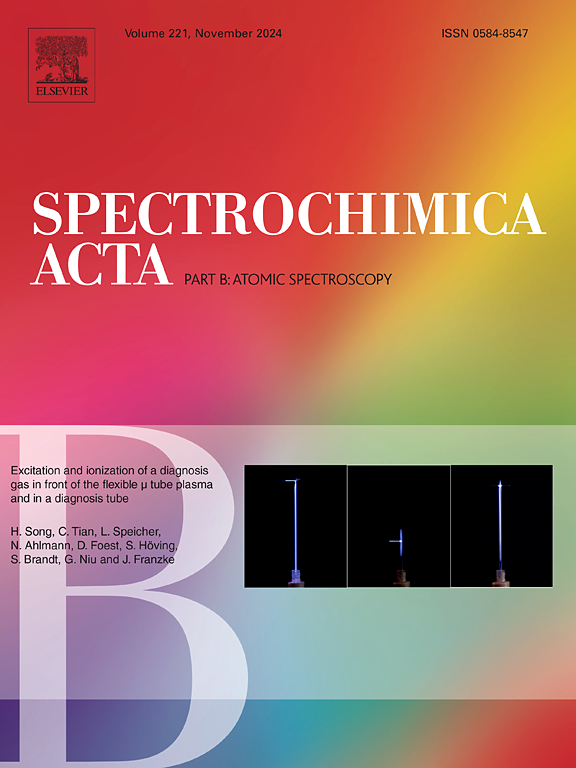Monte Carlo simulations of energy dispersive X-ray fluorescence (EDXRF) of liquid and metallic samples: A comparison and experimental validation of MCNP and XRMC codes
IF 3.8
2区 化学
Q1 SPECTROSCOPY
引用次数: 0
Abstract
The present study compares numerical simulations carried out by two Monte Carlo codes, the Monte Carlo N-Particle (MCNP) and the XRMC, of Energy Dispersive X-ray fluorescence (EDXRF) excited in liquid and metallic samples. The results are validated by measurements with a laboratory-made equipment, consisting of a mini X-ray tube (Moxtek, Inc., 4 W, Ag target) and a Si PIN detector model X123 (Amptek, Inc.), configured in the usual 45°/45° geometry. The liquid sample was a multielementar stock solution from High Purity Standards containing traces of the transition metals Cu, Fe, Mn, and Zn. For the solid samples, two metallic plates of standard reference materials were used, namely, a) a rectangular plate (6.9 mm × 43.4 mm, 1.5 mm thick) made of high purity copper; and b) a steel alloy plate (Duplex 2205 CRM) containing Si, Cr, Mn, Fe, Ni, Cu and Mo in its composition. The quantitative analysis of the relative peak intensities between the simulations and experiment reveals a difference of 0.4 % to 12.3 %, depending on the elemental characteristic line and sample composition. The results show an overall very good agreement between the simulations of the MCNP and XRMC codes with the experimental spectra, making them suitable for typical EDXRF applications involving metallic samples and multielement aqueous solutions.

液体和金属样品能量色散x射线荧光(EDXRF)的蒙特卡罗模拟:MCNP和XRMC代码的比较和实验验证
本研究比较了 Monte Carlo N-Particle (MCNP) 和 XRMC 这两种蒙特卡罗代码对液体和金属样品中激发的能量色散 X 射线荧光 (EDXRF) 进行的数值模拟。测量结果通过实验室自制设备进行了验证,该设备由一个微型 X 射线管(Moxtek 公司,4 W,银靶)和一个型号为 X123 的硅 PIN 探测器(Amptek 公司)组成,按通常的 45°/45° 几何结构进行配置。液体样品是高纯度标准的多元素储备溶液,含有痕量的过渡金属铜、铁、锰和锌。固体样品使用了两种标准参考材料金属板,即 a) 高纯度铜制成的矩形板(6.9 mm × 43.4 mm,厚 1.5 mm);b) 成分中含有 Si、Cr、Mn、Fe、Ni、Cu 和 Mo 的合金钢板(Duplex 2205 CRM)。对模拟和实验之间的相对峰强度进行定量分析后发现,根据元素特征线和样品成分的不同,两者之间的差异在 0.4 % 到 12.3 % 之间。结果表明,MCNP 和 XRMC 代码的模拟结果与实验光谱之间总体上非常吻合,因此适用于涉及金属样品和多元素水溶液的典型 EDXRF 应用。
本文章由计算机程序翻译,如有差异,请以英文原文为准。
求助全文
约1分钟内获得全文
求助全文
来源期刊
CiteScore
6.10
自引率
12.10%
发文量
173
审稿时长
81 days
期刊介绍:
Spectrochimica Acta Part B: Atomic Spectroscopy, is intended for the rapid publication of both original work and reviews in the following fields:
Atomic Emission (AES), Atomic Absorption (AAS) and Atomic Fluorescence (AFS) spectroscopy;
Mass Spectrometry (MS) for inorganic analysis covering Spark Source (SS-MS), Inductively Coupled Plasma (ICP-MS), Glow Discharge (GD-MS), and Secondary Ion Mass Spectrometry (SIMS).
Laser induced atomic spectroscopy for inorganic analysis, including non-linear optical laser spectroscopy, covering Laser Enhanced Ionization (LEI), Laser Induced Fluorescence (LIF), Resonance Ionization Spectroscopy (RIS) and Resonance Ionization Mass Spectrometry (RIMS); Laser Induced Breakdown Spectroscopy (LIBS); Cavity Ringdown Spectroscopy (CRDS), Laser Ablation Inductively Coupled Plasma Atomic Emission Spectroscopy (LA-ICP-AES) and Laser Ablation Inductively Coupled Plasma Mass Spectrometry (LA-ICP-MS).
X-ray spectrometry, X-ray Optics and Microanalysis, including X-ray fluorescence spectrometry (XRF) and related techniques, in particular Total-reflection X-ray Fluorescence Spectrometry (TXRF), and Synchrotron Radiation-excited Total reflection XRF (SR-TXRF).
Manuscripts dealing with (i) fundamentals, (ii) methodology development, (iii)instrumentation, and (iv) applications, can be submitted for publication.

 求助内容:
求助内容: 应助结果提醒方式:
应助结果提醒方式:


